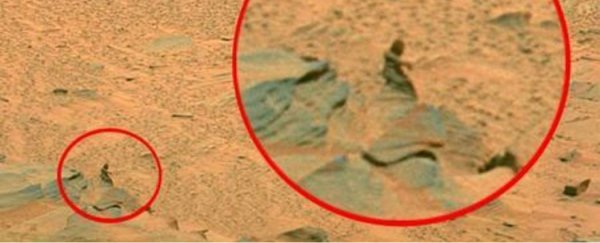Heard the one where Bigfoot and his date run into some kind of rat-lizard hybrid in their local Martian bar and hilarity ensues? If for some reason you answered yes to that question, congratulations! You might have a serious case of pareidolia that you should probably take care of before Jesus turns up in your tortilla again. Describing the common psychological phenomenon where an image or a sound prompts the mind to perceive something familiar that isn't actually there - such as a rabbit on the Moon or faces in buildings - pareidolia has found a perfect match in the various surface images of Mars that get shared around the Internet.
Where most of us see a slightly hazy pile of rocks, others see people, animals, faces, and flowers in images taken by NASA's Curiosity rover. Some even go so far as to count them as evidence that alien life really does occupy our favourite red planet (against all evidence to the contrary). But why? In the latest episode of SciShow, Hank Green explains that this phenomenon is nothing new, in fact, this famous picture of what looks like some kind of face or mask was taken by NASA's Viking 1 Orbiter spacecraft on Mars way back in 1976.
The concept is linked to those old Rorschach inkblot tests that used to be a common part of psychological examinations until they were debunked. Scientists have known for centuries that humans have a tendency to see familiar things - faces in particular - when presented with random patterns, but have only just recently gotten close to figuring out why.
In the video above, Hank describes how last year, an international team of researchers investigated the mechanisms behind two different types of pareidolia: one in which people specifically see faces, and another where they see letters and words. Participants were shown images of coloured static and were told that some of them contained images of letters or faces. Even though none of the pictures actually had images of letters or faces in them, more than a third of the participants reported seeing them in there - 34 percent said they saw faces, and 38 percent said they saw letters.
When the researchers looked at brain scans of the people who perceived these shapes, they found a spike of activity in what's known as the right faciform face area - the region that activates when we try to recognise someone's face. What's weird about this is that the people weren't actually seeing faces, they were just told that they might see images that looked like faces.
"This suggests that instead of being first triggered by a simple stimulus like an image of a human face, pareidolia automatically happens in the higher, more complex functions of the brain where the brain already thinks it's seeing a face and is trying to figure out who it is," says Hank.
And it turns out that certain people are more susceptible to experiencing pareidolia than others, according to a separate study. To find out if you're one, watch the video above. It just goes to show that our brains are like the most advanced machines we've been been smart enough to build - governed by incredibly complex patterns and mechanisms, they sometimes do strange things to us, but there's always a reason behind it if we know where to look.
